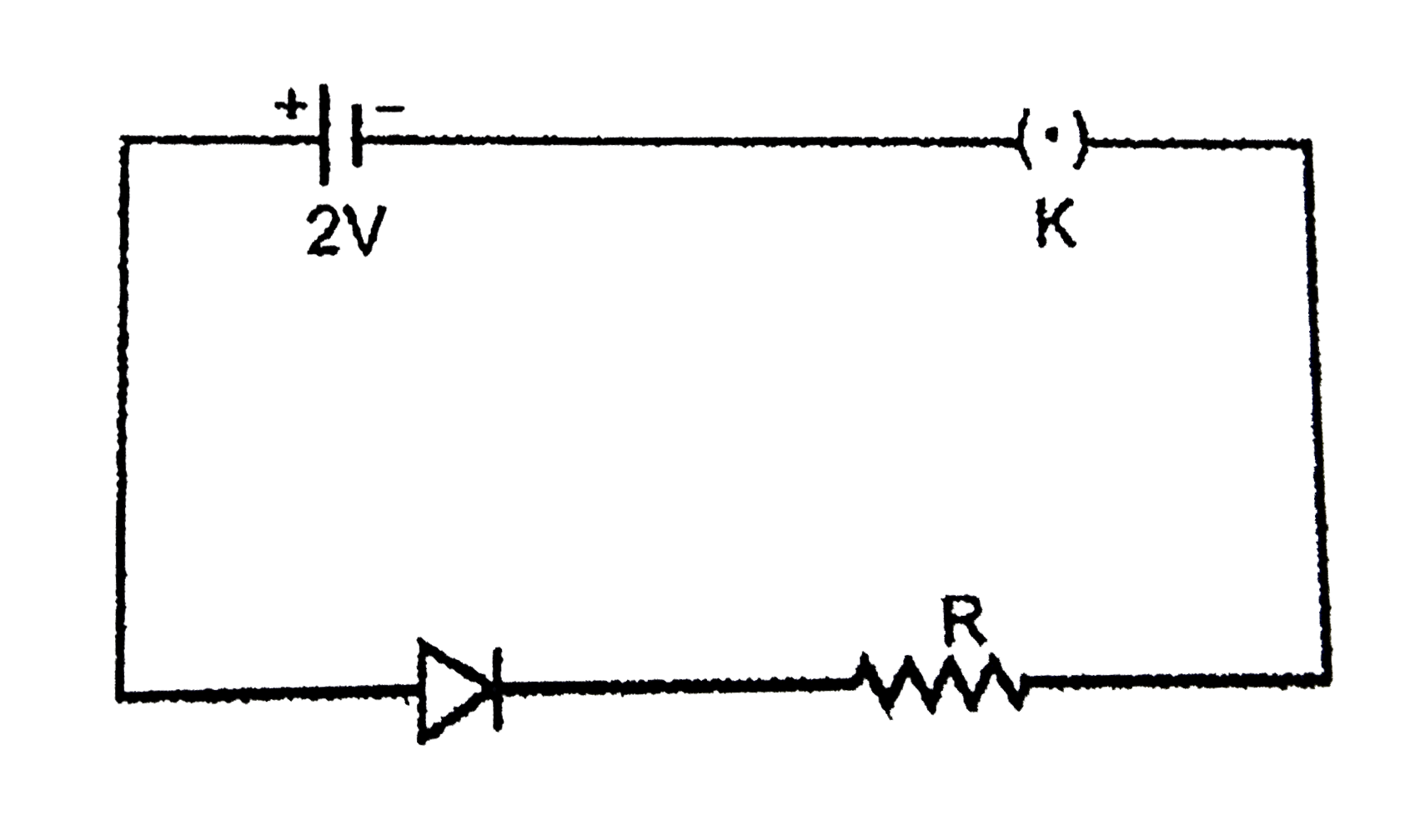A two volt battery forward biased and a diode. However, there is a drop of 0.5 V across the diode which is independent of current. Also, a current greater than 10 mA produces large joule loss and damages diode. If diode is to be operated at 5 mA, then the series resistance to be put is

3kΩ
300kΩ
300Ω
200kΩ
The correct Answer is:C
Step by step video & image solution for A two volt battery forward biased and a diode. However, there is a drop of 0.5 V across the diode which is independent of current. Also, a current greater than 10 mA produces large joule loss and damages diode. If diode is to be operated at 5 mA, then the series resistance to be put is by Physics experts to help you in doubts & scoring excellent marks in Class 12 exams.
Related Playlists
- BOOK - MOTIONCHAPTER - ELECTRONICS - SEMI CONDUCTOREXERCISE - EXERCISE - 232videos
ELECTRONICS - SEMI CONDUCTOR
- BOOK - MOTIONCHAPTER - ELECTRONICS - SEMI CONDUCTOREXERCISE - EXERCISE - 329videos
ELECTRONICS - SEMI CONDUCTOR
- BOOK - MOTIONCHAPTER - ELECTRONICS - SEMI CONDUCTOREXERCISE - ADVANTAGES OF SEMICONDUCTOR DEVICES OVER VACCUM TUBES3videos
ELECTRONICS - SEMI CONDUCTOR
- BOOK - MOTIONCHAPTER - ELECTROMAGNETISMEXERCISE - Exercise136videos
ELECTROMAGNETISM
- BOOK - MOTIONCHAPTER - ELECTROSTATICSEXERCISE - Exercise -3 Section (B) Previous Year Problems | JEE Main30videos
ELECTROSTATICS
Knowledge Check
- Question 1 - Select One

A diode made forward biased by a two volt battery however there is a drop of 0.5 V across the diode which is independent of current. Also a current greater then 10 mA produces large joule loss and damages diode. If diode is to be operated at 5 mA, the series resistance to be put isA3KΩB300KΩC300ΩD200Ω - Question 1 - Select One
A PN junction diode when forward biased has a drop of 0.5V which is assumed to be independent of current. The current in excess of 10mA through the diode produces large joule heating which damages the diode. If we diode, the resistor used in series with the diode so that the maximum current does not exceed 5mA is.
 .A2×102ΩB2×105ΩC2×103ΩD2×104Ω
.A2×102ΩB2×105ΩC2×103ΩD2×104Ω - Question 1 - Select One
A p-n junction diode when forward baiased has a drop of 0.5 V which is assumed to be independent of current. The current in excess of 10 mA through the diode produces a large joule heating which damages (burns) the diode. If we want to use a 15.V battery to forward bias diode a resistor of resistance a×102Ω is to be used in serise with the diode so that the maximum current does not exceed 5mA. what is the value of a?
A1B2C3D4 - Question 1 - Select One
A p-n junction diode when forward biased has a drop of 0.4 V which is assumed to be independent of current. A current excess of 10 mA through the diode damages (burns ) the diode. If we want to use a 2 V battery to forward bias the diode, what should be the value of resistor used in series with the diode so that the maximum current does not exceed 5 mA?
A130ΩB260ΩC390ΩD320Ω - Question 1 - Select One
A p-n jucntion when forward biased has a drop of 0.7 V which is assumed to be independent of current. The current in excess of 10 Ma through the diode produces a large joule heating effect which burns the diode. If we want to use 1.6 V battery to forward ibas the diode, the value of resistor used in series with the diode so that the maximum current does not exceed 6 mA should be
A50ΩB200ΩC150ΩD250Ω - Question 1 - Select One
A P−N junction diode can withstand currents up to 10mA. Under forward bias, The diode has a potential drop of 0.5V across it which is assumed to be independent of current. The maximum voltage of the battery used to forward bias the diode when a resistance of 200Ω is connected in series with it is
A2.5VB2.6VC2.7VD2.8V - Question 1 - Select One
In the circuit, if the forward voltage drop for the diode is 0.5 V, the current will be:
 A3.4 mAB2 mAC2.5 mAD3 mA
A3.4 mAB2 mAC2.5 mAD3 mA - Question 1 - Select One
In the circuit, if the forward voltage drop for the diode is 0.5 V, the current will be:
 A3.4 mAB2 mAC2.5 mAD3 mA
A3.4 mAB2 mAC2.5 mAD3 mA
Similar Questions
A p−n junction diode when forward biased has a drop of 0.5V which is assumed to be independent of current. The current in excess of 10mA through the diode produces a large Joule heating which damages (burns) the diode. If we want to use a 1.5V battery to forward bias the diode, what should be the vlaue of resistor used in series with the diode so that the maximum current does not exceed 5mA?
View SolutionA p-n junction when forward biased has a drop of 0.6V which is assumed to be independent of current. The current in excess of 10mAthrough the diode produces a large joule heating effect which burns the diode. If we want to use 1.5V battery to forward bias the diode, what should be the value of resistor used in series with the diode so that the maximum current does not exceed 6 mA?
View Solution

